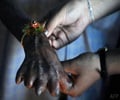Leprosy is infectious, and transmitted in a manner similar to ‘cold’; the only silver lining, that it is not as contagious as cold.
'The biggest disease today is not leprosy or tuberculosis, but rather the feeling of being unwanted.' - Mother Teresa
World Leprosy Day, which falls on 31st January 2007, is a day to increase public awareness about leprosy and to encourage the flow of funds, imperative to take the cause of leprosy eradication, forward. The central theme of every ‘World Leprosy Day’, seeks to provide cure for the disease in leprosy endemic regions, and enable the patients to lead a life of dignity. A holistic approach that ensures the smooth integration of the leprosy victims with the society forms the tenet of every World Leprosy Day.It might be worthwhile to look at recent statistics from epidemiological surveys sponsored by the World Health Organization, published in early August 2006. The reports have portrayed the incidence of 219,826 fresh cases of leprosy each year. Further, about 602 new cases of leprosy is detected everyday. Totally, there are nearly 10 million leprosy victims in the world today.
Leprosy is rife in the poorer regions of the world. India is home to nearly 70% of the leprosy cases in the world. Next is Brazil with about 6%, then Nepal and Indonesia, both with about 2%. Bangladesh, Myanmar, Tanzania, Mozambique, Madagascar, Nigeria and The Democratic Republic of Congo follow with about 1% of the world’s leprosy cases.
Leprosy, also called Hansen’s disease, is a chronic and contagious disease. The initial symptoms of the disease show up as light, painless patches on the skin; often, the lack of sensation in the area may cause the patient to completely neglect the initial symptoms. If left untreated, the infection gradually takes a toll on the skin and nerves.
As the disease advances, nerve damage along with other complication occurs. The lack of sensation in the limbs could cause wounds to worsen on the hands and feet. In later stages, deformities in the face and limbs become apparent. This may cause the victim to face stigma and alienation from society.
Leprosy is infectious, and transmitted in a manner similar to ‘cold’; the only silver lining, that it is not as contagious as cold. People living many years in leprosy endemic areas, especially where fresh cases of leprosy are detected, carry a greater risk of catching the infection.
Today, we know that leprosy is curable. Antibiotics are capable of annihilating the bacteria and within a few months of treatment, the disease can be completely cured. Patients can avoid several complications, if the disease is diagnosed early. In the event of complications, advanced medical treatment is capable of reversing nerve damage in some cases; today, even in the worst case scenario of non-reversibility of nerve damage, and a certain amount of disability, the person can be assisted with evolved rehabilitation methods, to help the victim start afresh.
It is important to adopt an integrated approach towards infected individuals that includes healthcare, education, rehabilitation and training. Today, there are many centers that provide specialist leprosy treatment and even reconstructive surgery for hands, feet and eyes. Socio-economic remedial initiatives are extremely crucial in the rehabilitation of leprosy patients, which will help them blend with society.
Community Based Rehabilitation (CBR) projects are vital to provide avenues to patients, especially those suffering disabilities. In India, such community based projects have offered financial support in the form of loans to patients, to begin businesses as a means of livelihood. Hundreds of patients are greatly benefited through the work of these rehabilitation centers.
Leprosy research has also made progress, evident in the decoding of the genome of Mycobacterium leprae, the causative organism in leprosy. Therefore, envisioning better ways of disease management and prevention is not mere wishful thinking. Yet, for all these initiatives to see the light of day, it is imperative that anti-leprosy services and health care providers work in tandem in leprosy endemic regions.
On this day, The World Health Organization has given an assurance that it will ceaselessly forge a partnership between public and private health care institutions, committed to the cause of leprosy. The most crucial fact lies in the change of attitude towards leprosy, which must be perceived like any other disease, in order to completely wipe-out the stigma associated with the disease.
Source-Medindia







